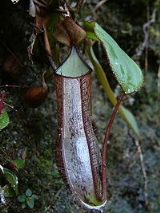
Nepenthes adnata
Encyclopedia
Nepenthes adnata is a tropical pitcher plant
endemic to the Indonesia
n province of West Sumatra
, where it grows at elevations of 600 to 1200 m above sea level. The specific epithet adnata is Latin
for "broadly attached" and refers to the base of the lamina.
on August 24, 1957. The holotype
, Meijer 6941, was collected on that date near the river Tjampo, east of Payakumbuh
, Taram, West Sumatra
, at an elevation of 1000 m. It is deposited at the National Herbarium of the Netherlands
in Leiden.
The species was first described in 1986 by Mitsuru Hotta
and Rusjdi Tamin based on specimens the authors collected near Harau
in West Sumatra
. However, the description was invalid as it lacked a Latin diagnosis. This was provided eight years later by Jan Schlauer.
are up to 10 cm long.
Leaves are coriaceous and sessile. The lamina is lanceolate-ellipsoidal and may be up to 10 cm long and 2 cm wide. It has an adnate base and an obtuse to acute apex. Two to three longitudinal veins are present on either side of the midrib. Pinnate veins are not easily distinguished. Tendril
s may be up to 5 cm long.
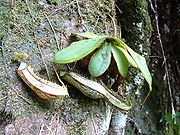 Rosette and lower pitchers are ovoid in the lower third and cylindrical above. They are small, reaching only 10 cm in height and 2.5 cm in width. A pair of fringed wings (≤3 mm wide) runs down the front of terrestrial pitchers. The glandular region covers only the lower third of the inner surface of pitchers. The pitcher mouth is round and slightly oblique throughout. The cylindrical peristome
Rosette and lower pitchers are ovoid in the lower third and cylindrical above. They are small, reaching only 10 cm in height and 2.5 cm in width. A pair of fringed wings (≤3 mm wide) runs down the front of terrestrial pitchers. The glandular region covers only the lower third of the inner surface of pitchers. The pitcher mouth is round and slightly oblique throughout. The cylindrical peristome
is up to 2 mm wide and bears indistinct teeth. The lid or operculum
is orbicular and cordate at the base. Multicellular hairs are sometimes present on its upper surface. An unbranched spur
(≤2 mm long) is inserted at the base of the lid.
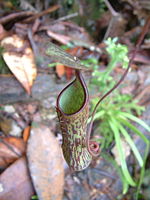 Upper pitchers are ovoid in the lower quarter and cylindrical to infundibular above. In aerial pitchers, the wings are usually reduced to ribs, but sometimes bear fringe elements. In most other respects, they are similar to lower pitchers.
Upper pitchers are ovoid in the lower quarter and cylindrical to infundibular above. In aerial pitchers, the wings are usually reduced to ribs, but sometimes bear fringe elements. In most other respects, they are similar to lower pitchers.
Nepenthes adnata has a racemose
inflorescence
. The peduncle
is up to 8 cm long. In male plants, the rachis
reaches 10 cm in length, while in female plants it rarely exceeds 7 cm. Pedicels
lack bract
eoles and are up to 10 mm long. Sepal
s are lanceolate-ovate and around 4 mm long. Fruits are up to 40 mm long.
Short brown hairs are present on the edges of the lamina. The stem and lamina bear a sparse indumentum
of simple white hairs (≤2 mm long). Inflorescences are covered with short, red-brown hairs.
The pitchers of N. adnata are generally speckled with reddish-purple blotches. The peristome is usually dark purple. The inner pitcher surface is white to light green. The stem and lamina are green throughout.
Nepenthes adnata varies little across its range. Consequently, no infraspecific taxa have been described.
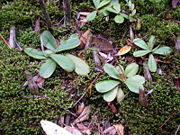 Nepenthes adnata is endemic to the mountains of the Tjampo river region of West Sumatra
Nepenthes adnata is endemic to the mountains of the Tjampo river region of West Sumatra
. Most ridges in this area have an elevation of just below 1000 m, although several exceed this height. The species has an altitudinal distribution of 600 to 1200 m above sea level. It grows on moss
y sandstone
cliff faces amongst dense vegetation. The habitat is moist and receives diffused sunlight.
In its natural habitat, the species occurs sympatrically with N. tenuis
and grows in close proximity to N. albomarginata
, N. ampullaria
, N. eustachya
, N. gracilis
, N. longifolia
, and N. reinwardtiana
. Despite this, N. adnata has no known natural hybrids. In Kelok Sembilan, the species has been found to grow alongside Utricularia striatula
, a distantly related carnivorous plant
.
Only two collections of this species have been made and these correspond to two populations separated by several kilometres of mountainous terrain. The species may be more widespread in the region, but most cliffs in the Tjampo river area are virtually inaccessible, making the discovery of new localities unlikely in the near future. The only population that is easily accessible is very small and frequently visited by plant collectors. Charles Clarke
considers this population "severely threatened". However, since the full extent of its range is unknown, the conservation status
of N. adnata is listed as Data Deficient
on the 2006 IUCN Red List of Threatened Species
. The habitat of this species may be threatened in the near future by fires deliberately started to clear forest for agricultural
purposes.
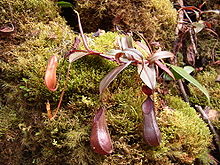 Nepenthes adnata has no obvious close relatives within the genus. Rusjdi Tamin and Mitsuru Hotta
Nepenthes adnata has no obvious close relatives within the genus. Rusjdi Tamin and Mitsuru Hotta
considered the species to be closely related to N. tentaculata
, N. gracillima
, and N. gracilis
. Both Jan Schlauer and Joachim Nerz
as well as Matthew Jebb
and Martin Cheek
agreed that N. adnata and N. tentaculata are related, while J. H. Adam
, C. C. Wilcock
and M. D. Swaine considered the two taxa conspecific. However, Charles Clarke
does not support this interpretation, stating that the similarities between the two species are probably coincidental and that the closest relatives of N. adnata "are more likely to be other Sumatran species such as N. gymnamphora
, N. longifolia
or N. albomarginata
". Clarke points out that the multicellular hairs sometimes exhibited by N.adnata, which several authors have used to suggest a relationship with N. tentaculata, occur in rosette pitchers of many other species, especially N. rafflesiana
.
The pitchers of N. adnata are similar to those of N. tobaica
, although the stem and lamina are quite different. They also bear a superficial resemblance to those of a form of N. gymnamphora from Mount Sorik Merapi. Seedlings of N. adnata and N. longifolia are virtually indistinguishable, although mature plants have few morphological features in common. N. adnata also shares with N. albomarginata a similar indumentum and ecology.
In 2001, Clarke performed a cladistic analysis of the Nepenthes species of Sumatra and Peninsular Malaysia
using 70 morphological characteristics of each taxon. The following is a portion of the resultant cladogram
, showing "Clade 6", which is only weakly supported at 50%. The sister pair of N. angasanensis
and N. mikei
has 79% support.
Pitcher plant
Pitcher plants are carnivorous plants whose prey-trapping mechanism features a deep cavity filled with liquid known as a pitfall trap. It has been widely assumed that the various sorts of pitfall trap evolved from rolled leaves, with selection pressure favouring more deeply cupped leaves over...
endemic to the Indonesia
Indonesia
Indonesia , officially the Republic of Indonesia , is a country in Southeast Asia and Oceania. Indonesia is an archipelago comprising approximately 13,000 islands. It has 33 provinces with over 238 million people, and is the world's fourth most populous country. Indonesia is a republic, with an...
n province of West Sumatra
West Sumatra
West Sumatra is a province of Indonesia. It lies on the west coast of the island Sumatra. It borders the provinces of North Sumatra to the north, Riau and Jambi to the east, and Bengkulu to the southeast. It includes the Mentawai Islands off the coast...
, where it grows at elevations of 600 to 1200 m above sea level. The specific epithet adnata is Latin
Latin
Latin is an Italic language originally spoken in Latium and Ancient Rome. It, along with most European languages, is a descendant of the ancient Proto-Indo-European language. Although it is considered a dead language, a number of scholars and members of the Christian clergy speak it fluently, and...
for "broadly attached" and refers to the base of the lamina.
Botanical history
Nepenthes adnata was first collected by Willem MeijerWillem Meijer
Willem 'Wim' Meijer was a Dutch botanist and plant collector.-Background and education:Meijer was born in 1923 in The Hague, Netherlands. He received his Ph.D. from the University of Amsterdam in 1951...
on August 24, 1957. The holotype
Holotype
A holotype is a single physical example of an organism, known to have been used when the species was formally described. It is either the single such physical example or one of several such, but explicitly designated as the holotype...
, Meijer 6941, was collected on that date near the river Tjampo, east of Payakumbuh
Payakumbuh
Payakumbuh is a city north-east of Bukittinggi , Indonesia. It has an area of 80.43 km² and a population of over 99,300 people. Literally translated, the city name means "grassy swamp"....
, Taram, West Sumatra
West Sumatra
West Sumatra is a province of Indonesia. It lies on the west coast of the island Sumatra. It borders the provinces of North Sumatra to the north, Riau and Jambi to the east, and Bengkulu to the southeast. It includes the Mentawai Islands off the coast...
, at an elevation of 1000 m. It is deposited at the National Herbarium of the Netherlands
National Herbarium of the Netherlands
The National Herbarium of the Netherlands was established in 1999 through a decentralized merger of the major university herbaria of Leiden , Utrecht and Wageningen...
in Leiden.
The species was first described in 1986 by Mitsuru Hotta
Mitsuru Hotta
is a Japanese botanist best known for his research on Araceae.Hotta was born in Osaka, Japan in 1937. He graduated from the Agricultural Department of Osaka Prefecture University in 1960. The same year, he took part in the Tonga and Fiji Expedition organised by Kyoto University...
and Rusjdi Tamin based on specimens the authors collected near Harau
Harau
Hărău is a commune in Hunedoara County, Romania. It is composed of four villages: Banpotoc , Bârsău , Chimindia and Hărău.-References:...
in West Sumatra
West Sumatra
West Sumatra is a province of Indonesia. It lies on the west coast of the island Sumatra. It borders the provinces of North Sumatra to the north, Riau and Jambi to the east, and Bengkulu to the southeast. It includes the Mentawai Islands off the coast...
. However, the description was invalid as it lacked a Latin diagnosis. This was provided eight years later by Jan Schlauer.
Description
Nepenthes adnata is a diminutive species. The stem is cylindrical in cross section and may be climbing or drooping. It rarely exceeds 2 m in length and 3 mm in diameter. InternodesPlant stem
A stem is one of two main structural axes of a vascular plant. The stem is normally divided into nodes and internodes, the nodes hold buds which grow into one or more leaves, inflorescence , conifer cones, roots, other stems etc. The internodes distance one node from another...
are up to 10 cm long.
Leaves are coriaceous and sessile. The lamina is lanceolate-ellipsoidal and may be up to 10 cm long and 2 cm wide. It has an adnate base and an obtuse to acute apex. Two to three longitudinal veins are present on either side of the midrib. Pinnate veins are not easily distinguished. Tendril
Tendril
In botany, a tendril is a specialized stem, leaf or petiole with a threadlike shape that is used by climbing plants for support, attachment and cellular invasion by parasitic plants, generally by twining around suitable hosts. They do not have a lamina or blade, but they can photosynthesize...
s may be up to 5 cm long.

Peristome
The word peristome is derived from the Greek peri, meaning 'around' or 'about', and stoma, 'mouth'. It is a term used to describe various anatomical features that surround an opening to an organ or structure. The term is used in plants and invertebrate animals, such as in describing the shells of...
is up to 2 mm wide and bears indistinct teeth. The lid or operculum
Operculum (botany)
An operculum, in botany, is a term generally used to describe a structure within a plant, moss, or fungus acting as a cap, flap, or lid. In plants, it may also be called a bud cap.Examples of structures identified as opercula include:...
is orbicular and cordate at the base. Multicellular hairs are sometimes present on its upper surface. An unbranched spur
Spur (biology)
A spur in botany is a spike, usually part of a flower.In certain plants, part of a sepal or petal develops into an elongated hollow spike extending behind the flower, containing nectar which is sucked by long-tongued animals . Plants with such structures include Delphinium, Aquilegia, Piperia, and...
(≤2 mm long) is inserted at the base of the lid.

Nepenthes adnata has a racemose
Raceme
A raceme is a type of inflorescence that is unbranched and indeterminate and bears pedicellate flowers — flowers having short floral stalks called pedicels — along the axis. In botany, axis means a shoot, in this case one bearing the flowers. In a raceme, the oldest flowers are borne...
inflorescence
Inflorescence
An inflorescence is a group or cluster of flowers arranged on a stem that is composed of a main branch or a complicated arrangement of branches. Strictly, it is the part of the shoot of seed plants where flowers are formed and which is accordingly modified...
. The peduncle
Peduncle (botany)
In botany, a peduncle is a stem supporting an inflorescence, or after fecundation, an infructescence.The peduncle is a stem, usually green and without leaves, though sometimes colored or supporting small leaves...
is up to 8 cm long. In male plants, the rachis
Rachis
Rachis is a biological term for a main axis or "shaft".-In zoology:In vertebrates a rachis can refer to the series of articulated vertebrae, which encase the spinal cord. In this case the rachis usually form the supporting axis of the body and is then called the spine or vertebral column...
reaches 10 cm in length, while in female plants it rarely exceeds 7 cm. Pedicels
Pedicel (botany)
A pedicel is a stem that attaches single flowers to the main stem of the inflorescence. It is the branches or stalks that hold each flower in an inflorescence that contains more than one flower....
lack bract
Bract
In botany, a bract is a modified or specialized leaf, especially one associated with a reproductive structure such as a flower, inflorescence axis, or cone scale. Bracts are often different from foliage leaves. They may be smaller, larger, or of a different color, shape, or texture...
eoles and are up to 10 mm long. Sepal
Sepal
A sepal is a part of the flower of angiosperms . Collectively the sepals form the calyx, which is the outermost whorl of parts that form a flower. Usually green, sepals have the typical function of protecting the petals when the flower is in bud...
s are lanceolate-ovate and around 4 mm long. Fruits are up to 40 mm long.
Short brown hairs are present on the edges of the lamina. The stem and lamina bear a sparse indumentum
Indumentum
The indumentum is a covering of fine hairs or bristles on a plant or insect.In plants, the indumentum types are:*pubescent*hirsute*pilose*villous*tomentose*stellate*scabrous*scurfy...
of simple white hairs (≤2 mm long). Inflorescences are covered with short, red-brown hairs.
The pitchers of N. adnata are generally speckled with reddish-purple blotches. The peristome is usually dark purple. The inner pitcher surface is white to light green. The stem and lamina are green throughout.
Nepenthes adnata varies little across its range. Consequently, no infraspecific taxa have been described.
Ecology

West Sumatra
West Sumatra is a province of Indonesia. It lies on the west coast of the island Sumatra. It borders the provinces of North Sumatra to the north, Riau and Jambi to the east, and Bengkulu to the southeast. It includes the Mentawai Islands off the coast...
. Most ridges in this area have an elevation of just below 1000 m, although several exceed this height. The species has an altitudinal distribution of 600 to 1200 m above sea level. It grows on moss
Moss
Mosses are small, soft plants that are typically 1–10 cm tall, though some species are much larger. They commonly grow close together in clumps or mats in damp or shady locations. They do not have flowers or seeds, and their simple leaves cover the thin wiry stems...
y sandstone
Sandstone
Sandstone is a sedimentary rock composed mainly of sand-sized minerals or rock grains.Most sandstone is composed of quartz and/or feldspar because these are the most common minerals in the Earth's crust. Like sand, sandstone may be any colour, but the most common colours are tan, brown, yellow,...
cliff faces amongst dense vegetation. The habitat is moist and receives diffused sunlight.
In its natural habitat, the species occurs sympatrically with N. tenuis
Nepenthes tenuis
Nepenthes tenuis is a tropical pitcher plant endemic to Sumatra. The species was first collected in 1957, from a remote mountain in the western part of the island. It remained undescribed until 1994, and was only rediscovered in the wild in 2002. Prior to this, N...
and grows in close proximity to N. albomarginata
Nepenthes albomarginata
Nepenthes albomarginata , the White-Collared Pitcher-Plant, is a tropical pitcher plant native to Borneo, Peninsular Malaysia, and Sumatra...
, N. ampullaria
Nepenthes ampullaria
Nepenthes ampullaria , the Flask-Shaped Pitcher-Plant, is a very distinctive and widespread species of Nepenthes, present in Borneo, Sumatra, Thailand, Peninsular Malaysia, Singapore, the Maluku Islands, and New Guinea...
, N. eustachya
Nepenthes eustachya
Nepenthes eustachya is a tropical pitcher plant endemic to Sumatra, where it grows from sea level to an elevation of 1600 m. The specific epithet eustachya, formed from the Greek words eu and stachys , refers to the racemose structure of the inflorescence.-Botanical history:Nepenthes eustachya...
, N. gracilis
Nepenthes gracilis
Nepenthes gracilis , or the Slender Pitcher-Plant, is a very common lowland pitcher plant that is widespread in the Sunda region. It has been recorded from Borneo, Peninsular Malaysia, Singapore, central Sulawesi, Sumatra, and southernmost Thailand...
, N. longifolia
Nepenthes longifolia
Nepenthes longifolia is a tropical pitcher plant endemic to Sumatra, where it grows at elevations of between 300 and 1100 m above sea level. The specific epithet longifolia, formed from the Latin words longus and folius , refers to the exceptionally large leaves of this species.-Botanical...
, and N. reinwardtiana
Nepenthes reinwardtiana
Nepenthes reinwardtiana , Reinwardt's Pitcher-Plant, is a Nepenthes species found on the islands of Borneo and Sumatra. Although some sources have included Peninsular Malaysia and Singapore within the range of this species, these records appear to be erroneous.Nepenthes reinwardtiana has an...
. Despite this, N. adnata has no known natural hybrids. In Kelok Sembilan, the species has been found to grow alongside Utricularia striatula
Utricularia striatula
Utricularia striatula is a small carnivorous plant that belongs to the genus Utricularia. It is widespread from tropical Africa to New Guinea. U. striatula grows as a lithophyte or epiphyte on wet rocks or tree trunks at altitudes from near sea level to . It was originally described by James...
, a distantly related carnivorous plant
Carnivorous plant
Carnivorous plants are plants that derive some or most of their nutrients from trapping and consuming animals or protozoans, typically insects and other arthropods. Carnivorous plants appear adapted to grow in places where the soil is thin or poor in nutrients, especially nitrogen, such as acidic...
.
Only two collections of this species have been made and these correspond to two populations separated by several kilometres of mountainous terrain. The species may be more widespread in the region, but most cliffs in the Tjampo river area are virtually inaccessible, making the discovery of new localities unlikely in the near future. The only population that is easily accessible is very small and frequently visited by plant collectors. Charles Clarke
Charles Clarke (botanist)
Dr. Charles M. Clarke is a botanist and taxonomist specialising in the carnivorous plant genus Nepenthes. Clarke has an honours degree in Botany from Monash University in Melbourne, and a Ph.D. in Ecosystem Management at the University of New England, in Armidale, New South Wales.Clarke first...
considers this population "severely threatened". However, since the full extent of its range is unknown, the conservation status
Conservation status
The conservation status of a group of organisms indicates whether the group is still extant and how likely the group is to become extinct in the near future...
of N. adnata is listed as Data Deficient
Data Deficient
Data Deficient is a category applied by the IUCN, other agencies, and individuals to a species when the available information is not sufficient for a proper assessment of conservation status to be made...
on the 2006 IUCN Red List of Threatened Species
IUCN Red List
The IUCN Red List of Threatened Species , founded in 1963, is the world's most comprehensive inventory of the global conservation status of biological species. The International Union for Conservation of Nature is the world's main authority on the conservation status of species...
. The habitat of this species may be threatened in the near future by fires deliberately started to clear forest for agricultural
Agriculture
Agriculture is the cultivation of animals, plants, fungi and other life forms for food, fiber, and other products used to sustain life. Agriculture was the key implement in the rise of sedentary human civilization, whereby farming of domesticated species created food surpluses that nurtured the...
purposes.
Related species

Mitsuru Hotta
is a Japanese botanist best known for his research on Araceae.Hotta was born in Osaka, Japan in 1937. He graduated from the Agricultural Department of Osaka Prefecture University in 1960. The same year, he took part in the Tonga and Fiji Expedition organised by Kyoto University...
considered the species to be closely related to N. tentaculata
Nepenthes tentaculata
Nepenthes tentaculata , or the Fringed Pitcher-Plant, is a tropical pitcher plant with a very wide distribution across Borneo and Sulawesi...
, N. gracillima
Nepenthes gracillima
Nepenthes gracillima is a highland Nepenthes pitcher plant species, native to Peninsular Malaysia.-Infraspecific taxa:*Nepenthes gracillima f. ramispina Hort.Westphal [=N. ramispina]...
, and N. gracilis
Nepenthes gracilis
Nepenthes gracilis , or the Slender Pitcher-Plant, is a very common lowland pitcher plant that is widespread in the Sunda region. It has been recorded from Borneo, Peninsular Malaysia, Singapore, central Sulawesi, Sumatra, and southernmost Thailand...
. Both Jan Schlauer and Joachim Nerz
Joachim Nerz
Dr. Joachim Nerz is a taxonomist and botanist specialising in the carnivorous plant genera Heliamphora and Nepenthes. Nerz has described several new species, mostly with Andreas Wistuba.-Publications:...
as well as Matthew Jebb
Matthew Jebb
Dr. Matthew H. P. Jebb is an Irish taxonomist and botanist specialising in the ant plant genera Squamellaria, Myrmecodia, Hydnophytum, Myrmephytum and Anthorrhiza, as well as the carnivorous plant genus Nepenthes....
and Martin Cheek
Martin Cheek
Dr. Martin Roy Cheek is a taxonomist and botanist specialising in the carnivorous plant genus Nepenthes.-Research:Cheek has described several new Nepenthes species, mostly with Matthew Jebb, including: N. argentii, N. aristolochioides, N. danseri, N. diatas,...
agreed that N. adnata and N. tentaculata are related, while J. H. Adam
J. H. Adam
Jumaat Haji Adam is a botanist and taxonomist specialising in the carnivorous pitcher plant genus Nepenthes.Adam has described numerous Nepenthes taxa, mostly with C. C. Wilcock, including the species N. faizaliana and N. mapuluensis, as well as the natural hybrids N. × alisaputrana, N. ×...
, C. C. Wilcock
C. C. Wilcock
Christopher C. Wilcock is a taxonomist specialising in the carnivorous pitcher plant genus Nepenthes.Together with J. H. Adam, Wilcock has described several Nepenthes taxa, including the species N. faizaliana and N. mapuluensis, as well as the natural hybrids N. × alisaputrana and N. ×...
and M. D. Swaine considered the two taxa conspecific. However, Charles Clarke
Charles Clarke (botanist)
Dr. Charles M. Clarke is a botanist and taxonomist specialising in the carnivorous plant genus Nepenthes. Clarke has an honours degree in Botany from Monash University in Melbourne, and a Ph.D. in Ecosystem Management at the University of New England, in Armidale, New South Wales.Clarke first...
does not support this interpretation, stating that the similarities between the two species are probably coincidental and that the closest relatives of N. adnata "are more likely to be other Sumatran species such as N. gymnamphora
Nepenthes gymnamphora
Nepenthes gymnamphora is a tropical pitcher plant native to the Indonesian islands of Java and Sumatra. There is much debate surrounding the taxonomic status of this species and the taxa N. pectinata and N. xiphioides....
, N. longifolia
Nepenthes longifolia
Nepenthes longifolia is a tropical pitcher plant endemic to Sumatra, where it grows at elevations of between 300 and 1100 m above sea level. The specific epithet longifolia, formed from the Latin words longus and folius , refers to the exceptionally large leaves of this species.-Botanical...
or N. albomarginata
Nepenthes albomarginata
Nepenthes albomarginata , the White-Collared Pitcher-Plant, is a tropical pitcher plant native to Borneo, Peninsular Malaysia, and Sumatra...
". Clarke points out that the multicellular hairs sometimes exhibited by N.adnata, which several authors have used to suggest a relationship with N. tentaculata, occur in rosette pitchers of many other species, especially N. rafflesiana
Nepenthes rafflesiana
Nepenthes rafflesiana , or Raffles' Pitcher-Plant, is a species of pitcher plant. It has a very wide distribution covering Borneo, Sumatra, Peninsular Malaysia, and Singapore. Nepenthes rafflesiana is extremely variable with numerous forms and varieties described. In Borneo alone, there are at...
.
The pitchers of N. adnata are similar to those of N. tobaica
Nepenthes tobaica
Nepenthes tobaica is a tropical pitcher plant endemic to Sumatra. It is particularly abundant around Lake Toba, after which it is named....
, although the stem and lamina are quite different. They also bear a superficial resemblance to those of a form of N. gymnamphora from Mount Sorik Merapi. Seedlings of N. adnata and N. longifolia are virtually indistinguishable, although mature plants have few morphological features in common. N. adnata also shares with N. albomarginata a similar indumentum and ecology.
In 2001, Clarke performed a cladistic analysis of the Nepenthes species of Sumatra and Peninsular Malaysia
Peninsular Malaysia
Peninsular Malaysia , also known as West Malaysia , is the part of Malaysia which lies on the Malay Peninsula. Its area is . It shares a land border with Thailand in the north. To the south is the island of Singapore. Across the Strait of Malacca to the west lies the island of Sumatra...
using 70 morphological characteristics of each taxon. The following is a portion of the resultant cladogram
Cladogram
A cladogram is a diagram used in cladistics which shows ancestral relations between organisms, to represent the evolutionary tree of life. Although traditionally such cladograms were generated largely on the basis of morphological characters, DNA and RNA sequencing data and computational...
, showing "Clade 6", which is only weakly supported at 50%. The sister pair of N. angasanensis
Nepenthes angasanensis
Nepenthes angasanensis is a highland Nepenthes pitcher plant species, native to Sumatra, where it grows at an altitude of 2200 to 2800 m. The status of this taxon is controversial as it is similar in morphology to N. mikei and N. tobaica.The specific epithet refers to Mount Puncak...
and N. mikei
Nepenthes mikei
Nepenthes mikei is a tropical pitcher plant endemic to Sumatra. It is characterised by its black mottled lower and upper pitchers. The species is closely related to N. angasanensis and N. tobaica....
has 79% support.
 |
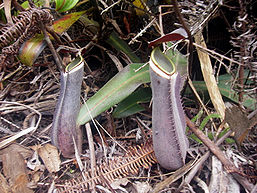 |
External links
- Photographs of N. adnata at the Carnivorous Plant Photofinder

